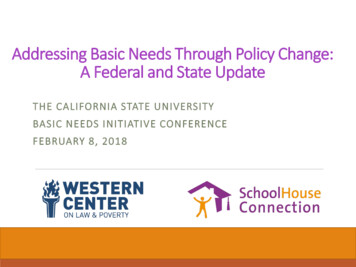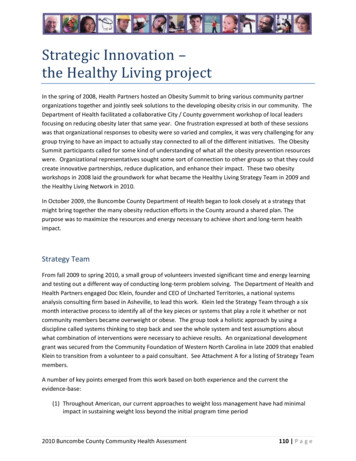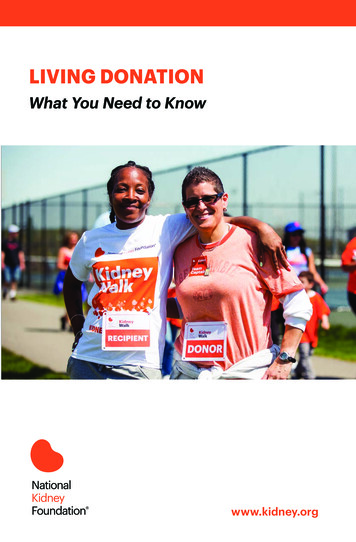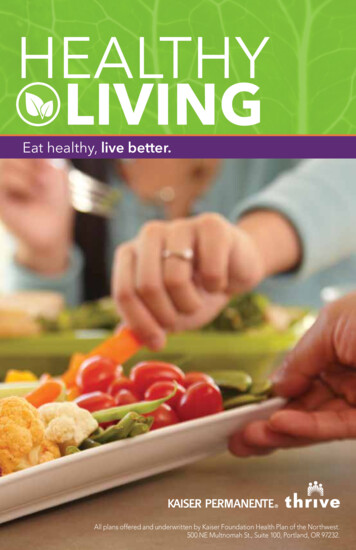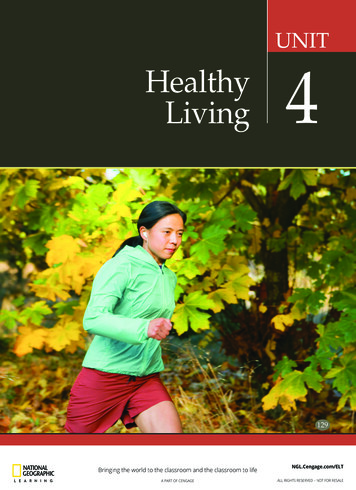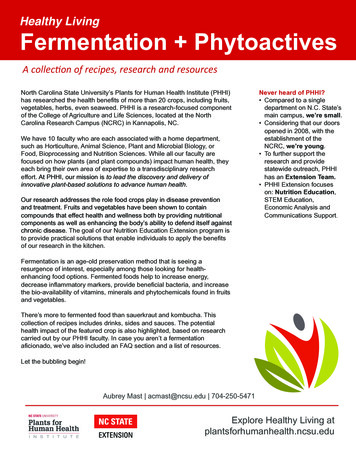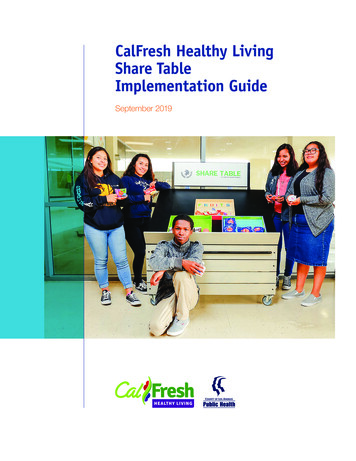
Transcription
CalFresh Healthy LivingShare TableImplementation GuideSeptember 2019
Table of ContentsBACKGROUND AND INTRODUCTION 2ADDRESSING FOOD INSECURITY AND FOOD WASTE2STATE AND LOCAL POLICIES AND DIRECTIVES THATSUPPORT SHARE TABLES 3IMPLEMENTING SHARE TABLES: A STEP-BY-STEPGUIDE FOR MAKING SHARE TABLES A REALITY 3CASE STUDY: NATIONAL HEALTH FOUNDATION 3SUPPORTING SHARE TABLE IMPLEMENTATION:ACTIVITIES FOR MAINTAINING EXISTING SHARE TABLES 12CASE STUDY: LAWNDALE ELEMENTARY SCHOOL DISTRICT12BEST PRACTICES FOR IMPLEMENTING AND MAINTAININGSHARE TABLES IN ANY SCHOOL SETTING 16FOOD DONATION 17REFERENCES 18
Background and IntroductionABOUT THIS GUIDEThe CalFresh Healthy Living Share Table ImplementationGuide was created for those who work in publicschools and are interested in reducing food wasteand addressing food insecurity among low-incomestudents by implementing share tables. This guideprovides information and best practices about theprocess of implementing share tables at school sites.It highlights the work of two CalFresh Healthy Livingfunded partners in Los Angeles County. The first casestudy includes a step-by-step approach for initiating,implementing, and sustaining share tables in a highschool setting with the involvement and engagementof high school students. The second case describeshow a school district supported and maintainedalready implemented share tables in elementary andmiddle schools.Share tables are tables or other sturdy surfaces wherestudents can place uneaten food and beverages froma district meal service (cafeteria lunch). This increasesthe access to nutritious foods while allowing otherstudents to take additional food or beverages at nocost. The use of share tables also reduces food wasteby preventing uneaten food from ending up in landfills.For information regarding items that can and cannot beplaced on a share table, please review the applicableCalifornia Health and Safety Code regulations in theShare Tables and Food Donations in Schools Guide.1This guide was created by the Los Angeles CountyDepartment of Public Health (LACDPH) EnvironmentalHealth Division’s Los Angeles County FoodRedistribution Initiative (LACFRI) and will be referencedthroughout the CalFresh Healthy Living Share TableImplementation Guide.School districts interested in implementing sharetables are encouraged to identify a championinterested in reducing food waste and/or addressingfood insecurity in their school community. An idealchampion would be someone who works within theschool district, understands the implementationprocess and can influence involvement from otherkey partners. Ultimately, the champion should becommitted to leading the effort and engaging theschool community to support the implementationof share tables. Identifying partners and securingfunding can also help schools establish, expand, andsustain their efforts. School districts can partner withcommunity-based organizations to provide additionalresources and expertise.A D D R ES S I N G FO O D I N S EC U R I T YA N D FO O D WAST EAccording to the United States Department ofAgriculture (USDA), establishing share tables is an“innovative strategy to encourage the consumption ofnutritious foods and reduce food waste” in schools.2The USDA specifies that foods and drinks donated viashare tables may be used to allow children to take anadditional helping of a food or beverage item from theshare table at no cost.In the U.S., nearly 13 million children, or 1 in 6 children,experience hunger every day.3 In California, 1.7 millionchildren, or 1 in 5 children, may go to bed hungry atnight.3 In Los Angeles County, 27.7% of households(approximately 223,000 households) below 300%of the Federal Poverty Level and living with childrenreported experiencing food insecurity. Additionally,9.6% of households (approximately 77,000 households)below 300% of the Federal Poverty Level and livingwith children reported very low food security.4Individuals who live in households that experience foodinsecurity face consistent barriers to purchasing healthyfoods. They often purchase less expensive foods that arehigher in calories, salt, sugar, and fat, but low in nutritionalvalue. Food insecurity during childhood may lead todelayed development, diminished academic performance,impaired social skills, and early onset of childhoodobesity. The experience of food insecurity, particularlyby students, indicates the need for achievable andsustainable solutions that improve access to nutritiousfood and reduce negative health consequences.CalFresh Healthy Living Share Table Implementation Guide2
At a time when the prevalence of food insecurity ishigh, 63 million tons of uneaten or unharvested foodis being sent to landfills each year in the U.S. Therotting food emits harmful greenhouse gases as itdecomposes.5 This represents a significant burdento the environment, in addition to the resources andenergy that are wasted.Nationally, the USDA’s National School Lunch Program,which serves 30 million students every school day,wastes 5 million worth of edible food each day,resulting in 1.2 billion in losses per school year.6 Inaddition, every year in Los Angeles County, roughly1.7 million tons of food are sent to landfills frombusinesses, schools, and households, accountingfor one-third of the state’s total food waste stream.7Uneaten, discarded food in schools alone creates atremendous amount of environmental waste.The existence of food waste and food insecurity makeit critical to identify ways to address both issues.Providing healthier food options through share tablesis a potentially effective way to address food insecurityamong students. However, it is also important to ensurethat students who live in households experiencing foodinsecurity are not stigmatized or feel uncomfortabletaking food from share tables. Possible discomfort maybe minimized by having students focus on reducingfood waste and making a positive contribution to theenvironment. Educating them about the impact foodwaste has on the environment and focusing on thesense of accomplishment felt by donating or taking foodis key to avoiding stigmatization. Reinforcing the positiveaspects of the students’ efforts can help sustain theshare tables, as students better understand the effectsof their actions. At the same time, students who livein households experiencing food insecurity can moreeasily access healthy foods using the share tables.STAT E A N D LO CA L P O L I C I ES A N D D I R ECT I V EST H AT S U PP O RT S H A R E TA B L ESOn January 1, 2018, the State of California enactedSenate Bill 557 Food Donation and Pupil Meals: Schools.3The purpose of the bill was to minimize food wasteand increase consumption of nutritious food amongstudents. This legislation permits schools districts to setup share tables where faculty, staff, and students canplace prepackaged, potentially non-hazardous fooditems and make those food items available to studentsduring regular school meal times. Amendments weremade to the California Health and Safety Code tospecify the conditions in which food could be donatedto ensure food safety. The bill also required that theCalifornia Department of Education’s (CDE) NutritionServices Division publish guidance on share tablesand food donation programs in schools. For moreinformation about Senate Bill 557, please refer to theShare Tables and Food Donations in Schools Guide.1In February 2019, the Los Angeles County Board ofSupervisors passed a motion titled, ‘Reducing BothFood Waste and Food Insecurity in Los AngelesCounty”. The motion included a directive for theDepartment of Public Health to work collaborativelywith other county departments and relevantstakeholders to increase awareness of and participationin food recovery efforts throughout LA County. Thisincluded calling for the development of strategies forschools to prevent food waste, redistribute surplusfood, and engage in complementary efforts to addressfood insecurity in schools, especially through thecreation of share tables.7Implementing Share Tables:A Step-by-Step Guide for Making ShareTables a RealityNational Health Foundation (NHF)CAS E ST U DY:Background: The Los Angeles County Departmentof Public Health’s Nutrition and Physical ActivityProgram partnered with National Health Foundation(NHF) to develop and implement share tables in twoLos Angeles United School District (LAUSD) highschools in South Los Angeles with CalFresh Healthy
Living Program funding. NHF convened a student taskforce consisting of 12 students at each high school.The students in the task force played a critical role inensuring the share tables were developed, promoted,implemented and maintained.NHF, whose mission is to improve the health ofindividuals and under-resourced communities byaddressing the social determinants of health, utilized theYouth Participatory Action Research (YPAR) frameworkto engage students in implementing policy, systems,and environmental changes to increase access tohealthier foods. YPAR is an innovative approach topositive youth and community development basedon social justice principles in which young people aretrained to conduct systematic research to improve theirlives, their communities, and the institutions intendedto serve them.8 The funding allowed NHF to becomemore involved with the students, training them on YPARconcepts and preparing them to take on projects thatfocused on the health of the community. Part of thisprocess included teaching students to propose ideasand engage stakeholders and decision makers. Thisled to the formation of the student task force known asHealth Academy.Health Academy discussed how to address the issuesidentified. The group also realized the need to collectdata and conduct research to validate their claimsand take action. Students began researching hungerstatistics in South LA, student hunger, and food wastereduction initiatives. Through this research, studentsdiscovered share tables as a way to address foodwaste and hunger.Pilot Testing the Share Tables. After conductingtheir research, the Health Academy developed asurvey to assess the attitudes and perceptions of thestudent body. The Health Academy involved the SchoolWellness Council (SWC) and other school staff andadministrators to discuss addressing student hungerand food waste. With help from the SWC, the HealthAcademy conducted the survey. They found the resultsHealth Academy exists at two LAUSD high schools andwas introduced and presented to school administratorsas a student leadership and development program.NHF’s established, ongoing partnership with LAUSDschools, combined with CalFresh Healthy Livingfunding, helped make the share table program a reality.Identifying Student Hunger Issues. After trainingHealth Academy students on YPAR fundamentals,the students were encouraged to investigate how toimprove access to healthy food and student health attheir school cafeteria. One student noticed that thecafeteria was in good shape, offering plenty of healthyfood options. However, they observed that somestudents threw away a lot of food, while many studentswent home and had little to eat. Other studentsagreed, and over the next few meetings, NHF and theHealth Academy students learn about share tablessupported their initial findings: students knew therewere healthy options available, and they also threwaway a lot of food. After collecting and analyzing surveydata, the Health Academy discussed the following toaddress their findings: moving/adjusting the trash cansCalFresh Healthy Living Share Table Implementation Guide4
and/ or getting recycle and compost bins, or startinga share table. The SWC agreed to support HealthAcademy’s research and proposals to address studenthunger and food waste.The Health Academy conducted the researchnecessary to evaluate both options and ultimatelydecided to test a share table. Though this testwas smaller than a full pilot program, the HealthAcademy students wanted to assess the process ofimplementing a share table and informed the schooladministrators and cafeteria manager about theirintentions. With assistance from NHF’s CalFreshHealthy Living program, the Health Academyconducted a few days of testing. The studentsdetermined the share table project could be relativelyeasy to conduct, track and research, as well as be apotentially effective way to address student hunger.ST EPS FO R I M PL EM EN T I N GA S H A R E TA B L EGETTING STARTEDThe process of developing a sustainable share tableat a school site can be divided into the followingfive steps:1. Develop a share table task force2. Conduct a food waste audit and pilot theshare tables3. Create a campaign to promote the launch ofthe share tables4. E valuate the impact of the share tableswithin the school setting5. D etermine how to sustain share tables onceimplementedStep 1: Developing a Share Table Task ForceThe first step in developing a share table task force is togarner support from various stakeholders at a schoolsite. Those joining the task force will be involved in5initiating and monitoring the share table process. Thestakeholders involved in the task force can vary, butthey should have an interest in reducing food waste,improving the school environment or improving studenthealth. The following list includes potential stakeholdersat a school site and defines what their role would be inimplementing the share tables:1. Students: Student task force members can berecruited from health classes, sports teams or clubs.Students provide the best insight into where themajority of students eat, throw away their food andwhat food items typically get thrown away. They canalso share how to promote the share table to otherstudents. Students can also help to recruit otherstakeholders, such as teachers and school staff.2. Cafeteria Manager and Staff: Cafeteria staff canexplain food regulations and safe handling practices,as well as assist with maintenance, such as storingthe table over school breaks.3. School Administration & Teachers: Schooladministrators can provide legitimacy to the projectby approving the implementation of share tables andencouraging school staff and students to participate.4. Parents: Parents who already volunteer at a schoolsite can provide assistance in establishing andrunning a share table. Parents can monitor the usageof the table and clean up, when necessary.Task Force Meetings: The task force shouldmeet weekly for the first month to engage membersand ensure understanding and commitment to theprocess. The first few meetings should focus ontraining and team building and include lessons aboutshare tables and how to conduct research. Teambuilding activities, such as icebreakers or games,should be incorporated to encourage camaraderie andfoster good working relationships.
taking up too much of their time, is important. Forexample, task force members can plan agendas andprepare training materials for presentations to sharefindings and proposed solutions. Assignments can becompleted outside of the meetings, allowing membersto accomplish activities at times convenient for them.Additionally, setting meeting agendas can be aninformal, flexible process determined by the concernsand interests of the task force members.BE S T PR AC T ICE:Include team building activities,such as icebreakers or games,in the initial meetings to encouragecamaraderie and foster goodworking relationships.After the initial meetings, the following meetings shouldallow for planning, assigning roles and conductingresearch. This includes: Identifying key stakeholders and determining howthey can support the share table Researching issues related to food waste andstudent hunger Brainstorming potential opportunities and challengesfor engaging students in the share table process Creating share table presentations tailored to specificgroups (cafeteria workers, school admin) Developing a work plan to document expectedtimelines for events, how resources will be utilized,and tracking the progress of assigned tasksMeetings can be used to plan presentations to thecafeteria team and school administration. The taskforce can invite the appropriate people to the followingmeetings to present their research and ideas. Oncethe share table has launched, task force meetings mayconsist of quick updates and reporting, action planning,and deciding upon and assigning next steps.Continuously engaging task force members to maintaintheir interest in and commitment to the project, without2Utilizing the YPAR Framework: Student task forcemembers should be encouraged to do thoroughresearch on student hunger and food waste to establishunderstanding and importance of improving health andreducing waste amongst all involved. Data collectedfrom this research will be used to garner stakeholdersupport, validate the project and set up the long-termevaluation questions. The YPAR framework can beused to train students to conduct research, collectdata and put relevant information into practice. YPARconcepts of self-discovery and practicing real-life skillsguide students as they conduct the research process.Applying these concepts is significant, in light of arecent study, because expanding civic engagementfor youth through school programs is associated withbetter health status, fewer sick days at school, andbetter grades.9 Students on the task force can utilize aschool’s computer lab or library to research statisticsand other data on food waste and student hunger,with staff guidance, to find validated, evidence-baseddata. The information collected should be shared at thenext task force meeting to promote discussion aboutconducting further research on any identified trends,including topics such as school food waste, studenthunger statistics and best practices for share tables.Addressing Unexpected Problems. Despite soundplanning, problems may still arise that the task forcedid not anticipate. For example, food may be left on thetable and not picked up, or certain items may remainon the share table the next day. Teachers may borrowthe food donation baskets to use as materials in theirclassroom and forget to return them.CalFresh Healthy Living Share Table Implementation Guide6
Within a school setting, change is an ongoing factorand resources may be consistently low. In dealing withany issues that arise, it is important for the task force toaddress them right away. If the task force notices foodis left on the tables overnight, they should connect withthose monitoring and find out if assistance is needed.Understanding existing challenges allows the taskforce to provide additional assistance or training asneeded and be better prepared to respond to similarsituations in the future. While problems are inevitable,having a well-trained task force with a comprehensiveplan of action will ensure problems are addressed andresolved in a timely manner.Step 2: Conducting a Food Waste Audit andPiloting the Share TablesConducting the Food Waste Audit: Once the taskforce has been established, conducting a food wasteaudit to gather information about how much food isthrown away and where food is discarded will helpidentify locations to pilot a share table. The task forceshould follow the instructions for conducting the auditas outlined in the USDA’s Guide to Conducting StudentFood Waste and Audits.10Divide the task force members into teams of two to fourindividuals to conduct the food waste audit and havethe teams spread out across student eating areas toensure there is no overlap. The best time to conductthe audits is immediately after lunch or during otherITEMS YOU WILL NEED FOR THE AUDIT: Gloves Trash bags Long-handled trash grabber Food waste audit tally sheet Clip boards Pens and pencils7Health Academy students conducting a food waste auditmeal periods. Students conducting the audit shouldobtain permission to stay after the meal.Piloting the Share Table: Once the food audit iscomplete, the information gathered will help determinethe best locations for piloting and testing the sharetables. Select at least three locations to test and placethe share table at a different location each chosen day.The task force can plan promotional activities, suchas putting up signs explaining what a share table is,having a task force member stand next to the table,and making announcements over the school intercom.The main purpose of the pilot is to determine whichlocation garners the most attention.A few task force members should be monitoring theshare table during the pilot testing phase to keep a
students to the share table and posters can bedesigned and placed around the school to educatestudents on food waste, student hunger, healthyeating and promoting the share table.ITEMS NEEDED FOR A SHARE TABLE: A table (lunch table or folding table) Baskets or tubs to collect food items Signs indicating where food shouldbe placed A share table sign with minimaldirectionstally of those seen using the share table and documentwhether students donate or take food. They shouldobserve the foot traffic around the share table to notewhether it is busy, if it is in the way, or if it slows downlunch lines. These observations enable the task forceto determine the best location and ease for students.After the share table has been pilot tested, the taskforce will hold a meeting to discuss findings, decide ona location, and plan for the launch of the tables.Step 3: Creating a Campaign to Promote theLaunch of the Share TablesOnce a tablelocation has beenselected, thetask force shouldobtain approvalfrom the schooladministration andcafeteria workers.Ideally, the sharetable shouldbe launched on a Monday to allow the campaign tocontinue for a full week.Prior to the launch, several activities should beconducted, including decorating or painting collectionbaskets and ensuring that separate baskets are usedfor different types of food (cold foods, hot foods,fruits and vegetables, packaged items, etc.). Colorfuland concise signs should also be created to directOnce the materials are ready, task force members canplan the launch. The task force should assign membersto do the following activities: set out the baskets andput up signs before the meal period, clean off and putaway the baskets after the meal period, and ensure thatat least two task force members are available to standby the table to speak with students about the table.Designing a fun and creative campaign duringthe launch is instrumental in promoting the sharetable and securing the awareness of the studentpopulation. The campaign can involve posters aroundthe school, classroom presentations, and schoolannouncements. Social media posts and videos canbe created by the task force to highlight the benefitsof the share table. Student task force membersshould be encouraged to lead the campaign, as theyknow what will help students utilize and understandthe share table. Providing students with examples ofwhat can and cannot be donated to the share tablewill ensure appropriate donations. For example, it isUSING SOCIAL MEDIA TOPROMOTE SHARE TABLES:https://www.youtube.com/user/NHFCAimportant students understand they cannot donatefood brought from home. Additional information canbe found in the California Health and Safety Code,which specifies what items can and cannot be placedon a share table to ensure the health and safety ofthe food that is donated. This information can also belocated in the Share Tables and Food Donations inSchools guide1 under the section Appropriate FoodItems for Share Tables.CalFresh Healthy Living Share Table Implementation Guide8
Step 4: Evaluating the Impact of the Share TablesConducting an evaluation of the share table enablesthe task force to know if the share table is havingthe intended effect—reducing food waste, alleviatinghunger, and promoting health. Surveying the studentsand assessing their understanding of share tables isan integral part of the evaluation process. Additionally,obtaining feedback at different points in time allowsthe task force to determine what their next steps willbe. Brief, straightforward survey tool questions can bedeveloped for students to easily complete. This toolcan be used to evaluate the share table at least threedifferent times during the school year. The task forceSAMPLE SURVEY TOOL QUESTIONS1. Do you know what the share tableis? (Yes/No)2. Which location is best for the sharetable? (List of locations)3. How accessible is it? (Likert scalewith 1 Difficult and 5 easy)4. O n average, how many days perweek do you use the share table?(0 days, 1-2 days, 3-4 days, 5 days)5. Do you think the share table makesa difference? (Yes/No)can provide input regarding the types of questionsstudents will be most likely to respond to. The samequestions should be used in each phase of theevaluation to allow the task force to assess changes inknowledge and understanding, but also gives studentsthe opportunity to provide open-ended feedback.Based off this feedback, the task force can adjusttheir promotional and educational efforts as needed.A random sample of students should be surveyedduring each evaluation phase. Lastly, the task forceshould identify several different areas where they plan9to administer the survey to ensure they capture a broadcross section of the student population.Formative or Process Evaluation. Formativeevaluation is research conducted during thedevelopment and implementation of a project.A formative evaluation will aid the task force indetermining whether early improvements need to bemade to the share table. Formative evaluation can beconducted within a week or two of the share tablelaunch. Another food waste audit can be conductedduring this time to determine if the share table hasmade an impact on the amount of edible food beingdiscarded. In addition, surveying students will helpassess whether they understand, use, or have seenthe share table. If the students surveyed are unclear onthe share table concept, do not use it, or food wastehas not decreased, the task force should reconveneand decide how to improve their promotional andeducational efforts.Summative Evaluation. Summative evaluation isresearch to assess whether the project met its desiredgoal. A summative evaluation should be conducteda few weeks to a few months after the launch of theshare table, with a focus on surveying students on theirunderstanding and use of the share table. The resultsof this evaluation will indicate if the share table programis feasible for the future, if the program should beexpanded to two tables, or to provide suggestions forimprovement.Impact Evaluation. Impact evaluation assesses theproject’s long-term effect on people by measuringawareness, knowledge, attitude, and behavior change.The purpose of conducting an impact evaluation isto gauge the long-term impact of share tables on theschool. It can occur several months to a year after theinitial launch and can be conducted annually after thatto assess whether the share table has consistentlyreduced food waste. The task force can pursue otheroptions to determine the impact of the share table,such as interviewing the cafeteria team to find out
if they reduced the amount of food purchased. Aswith the previous stages of the evaluation process,the students can be surveyed to determine if theirunderstanding of the importance of reducing studenthunger and food waste has changed since theimplementation of the share table(s). In addition, sharetable use can be evaluated as well to determine ifthe table location needs to be changed or if anothercampaign should take place to educate new studentsand improve the functionality of the table.Surveying the Students. NHF’s CalFresh HealthyLiving staff assisted Health Academy students withevaluating the knowledge, attitudes and perceptionsof the student body in relation to the share tableprograms at their high schools. In earlier stages ofthe evaluation process, Health Academy studentsdeveloped and distributed surveys to students whopassed by the share table. Eventually, they decidedto create confidential surveys which they distributedin a few of their classrooms. They felt this would elicitmore responses than having students stand by tablesand fill out a survey. The survey questions resembledquestions from earlier stages of the evaluation process,but also provided students with the opportunity toinclude comments, questions or suggestions aboutthe share table. Obtaining more extensive input fromthe students allowed the Health Academy to accuratelyassess the impact of the share table.The results of the confidential surveys were analyzed byNHF and the Health Academy. Initial findings showedthat 35.9% reported they used the table anywhere fromone to five days per week and 55% reported they feltthe share table makes a difference. Other responsesprovided indicated students still throw food away,are unaware of the share table, or feel that it needsto be promoted more. The feedback provided by thestudents helped the Health Academy determine howto improve the tables and whether another week ofmarketing/promotion was needed.Step 5: Determining how to sustain theuse of the share tables once they havebeen implementedShare Table Guidelines developed by the Health Academyand NHFThe ongoing operation and maintenance of sharetables is a key component to the success of reducingstudent hunger and food waste. Having a sustainabilityplan for the share table is necessary to ensure itcontinues to have the intended impact. Part of the planshould include selecting a diverse group of members,such as teachers, parents, cafeteria staff and studentsas outlined in Step 1: Developing a share table taskforce. Recruit parent volunteers from the parent centerif possible; parents can take responsibility for checkingthe share table and reporting if there is damage or anCalFresh Healthy Living Share Table Implementation Guide10
Share table at an LESD elementary schoolunusual amount
CalFresh Healthy Living Share Table Implementation Guide4 Living Program funding. NHF convened a student task force consisting of 12 students at each high school. The students in the task force played a critical role in ensuring the share tables were developed, promoted, implemented and m

